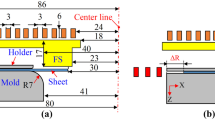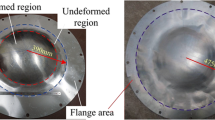Abstract
Electromagnetic forming (EMF) was used to conduct elongated hole flanging in this work. The investigation showed that the low geometry accuracy around the elongated hole flanging attributed from an uncoordinated deformation occurred, including unequal flanging heights and different rebound amounts between the straight edges and the circular edges. The uncoordinated flanging height resulted from different strain distribution. The strain distribution of the circular edges was similar to circular hole flanging, while the strain distribution of the straight edge regions was similar to sheet stretch bending. The uncoordinated rebound amount resulted from different deformation mechanisms, stress distribution, and structural stiffness within the forming regions. To improve the geometry accuracy of the elongated hole flanging, a two-step method combined geometric compensation electromagnetic forming (GC-EMF) and electromagnetic calibration (EM calibration) was proposed. GC-EMF was used to achieve equal flanging height by optimizing the prefabricated hole, while EM calibration after GC-EMF was used to improve the forming accuracy by reducing the amount of rebound. The difference in the flanging heights between the straight edges and the circular edges was only 0.1 mm after the GC-EMF process, when the compensation dimension on both sides of the straight edges of a prefabricated hole was 3.4 mm. The gap between the die and the straight edges was 0.2 mm, the gap between the die and the circular edges was 0.1 mm, after EM calibration. Therefore, the improved geometry accuracy of the elongated hole flanging was achieved by combining the GC-EMF with EM calibration. The results obtained and the method proposed in this work present significant guidance for the process of elongated hole flanging or other irregular hole flanging by EMF.



















Similar content being viewed by others
References
Hirsch J, Al-Samman T (2013) Superior light metals by texture engineering: optimized aluminum and magnesium alloys for automotive applications. Acta Mater 61:818–843
Zhang XS, Chen YJ, Hu JL (2018) Recent advances in the development of aerospace materials. Prog Aerosp Sci 97:22–34
Kim HS, Koc M (2008) Numerical investigations on springback characteristics of aluminum sheet metal alloys in warm forming conditions. J Mater Process Technol 204:370–383
Su HL, Huang L, Li JJ, Ma F, Huang P, Feng F (2018) Two-step electromagnetic forming: a new forming approach to local features of large-size sheet metal parts. Int J Mach Tools Manuf 124:99–116
Yang C, Wen T, Liu LT, Zhang S, Wang H (2014) Dieless incremental hole-flanging of thin-walled tube for producing branched tubing. J Mater Process Technol 214:2461–2467
Huang YM (2007) An elasto-plastic finite element analysis of the sheet metal stretch flanging process. Int J Adv Manuf Technol 34:641–648
Borrego M, Morales-Palma D, Martínez-Donaire AJ, Centeno G, Vallellano C (2016) Experimental study of hole-flanging by single-stage incremental sheet forming. J Mater Process Technol 237:320–330
Lin HS, Lee CY, Wu CH (2007) Hole flanging with cold extrusion on sheet metals by FE simulation. Int J Mach Tools Manuf 47:168–174
Psyk V, Risch D, Kinsey BL, Tekkaya AE, Kleiner M (2011) Electromagnetic forming—a review. J Mater Process Technol 211:787–829
Okoye CN, Jiang JH, Hu ZD (2006) Application of electromagnetic-assisted stamping (EMAS) technique in incremental sheet metal forming. Int J Mach Tools Manuf 46:1248–1252
VanBenthysen R, Thibaudeau E, Kinsey BL (2013) Effect of specimen planar area on electromagnetic flanging. J Manuf Process 15:194–200
Su HL, Huang L, Li JJ, Li GD, Huang P (2017) Investigation on the forming process and the shape control in electromagnetic flanging of aluminum alloy. Procedia Engineering 207:335–340
Kim JH, Kim D, Lee MG (2015) Experimental and numerical analysis of a rectangular helical coil actuator for electromagnetic bulging. Int J Adv Manuf Technol 78(5–8):825–839
Cao QL, Li ZH, Lai ZP, Li ZZ, Han XT, Li L (2019) Analysis of the effect of an electrically conductive die on electromagnetic sheet metal forming process using the finite element-circuit coupled method. Int J Adv Manuf Technol 101:549–563
Yu HP, Zheng QL, Wang SL, Wang Y (2018) The deformation mechanism of circular hole flanging by magnetic pulse forming. J Mater Process Technol 257:54–64
Liu W, Zou XF (2019) Electromagnetic-assisted calibration for surface part of aluminum alloy with a dedicated uniform pressure coil. Int J Adv Manuf Tech 100:721–727
Yu HP, Chen J, Liu W, Yin HZ, Li CF (2018) Electromagnetic forming of aluminum circular tubes into square tubes: experiment and numerical simulation. J Manuf Process 31:613–623
Golovashchenko SF (2005) Springback calibration using pulsed electromagnetic field. AIP conference proceedings a: 284–285
Noh HG, Song WJ, Kang BS, Kim J (2015) Two-step electromagnetic forming process using spiral forming coils to deform sheet metal in a middle-block die. Int J Adv Manuf Technol 76(9–12):1691–1703
Cui XH, Yu HL, Wang QS (2018) Electromagnetic impulse calibration in V-shaped parts. Int J Adv Manuf Technol 97:2959–2968
Liu DH, Li CF, Yu HP (2009) Numerical modeling and deformation analysis for electromagnetically assisted deep drawing of AA5052 sheet. Trans Nonferrous Metals Soc China 19:1294–1302
Funding
We gratefully acknowledge the financial support of the National Natural Science Foundation of China (Grant Nos. 51675128, 51475122).
Author information
Authors and Affiliations
Corresponding author
Additional information
Publisher’s note
Springer Nature remains neutral with regard to jurisdictional claims in published maps and institutional affiliations.
Rights and permissions
About this article
Cite this article
Yu, H., Jin, Y., Hu, L. et al. Two-step method to improve geometry accuracy of elongated hole flanging by electromagnetic forming. Int J Adv Manuf Technol 106, 3117–3129 (2020). https://doi.org/10.1007/s00170-019-04820-w
Received:
Accepted:
Published:
Issue Date:
DOI: https://doi.org/10.1007/s00170-019-04820-w




